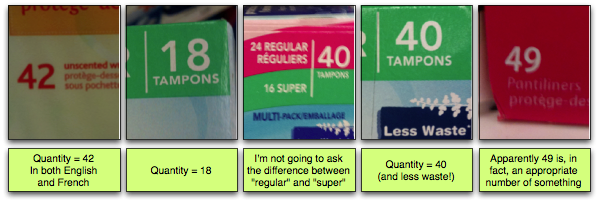Okay, I’m going to preface this article by saying that some ladies and gentlemen may not wish to read further. The example I’m about to use to demonstrate my point surrounds a topic many polite people don’t like to discuss.
That being said, I was on my local drug store’s website this weekend to see if they rented post office boxes on the hopes I could find one nearby for my business. (For my non-Canadian readers, Canada Post and Shoppers’ Drug Mart, a local chain, have a partnership arrangement, so it’s not as random as it sounds).
When I visited their website, I saw in giant letters, the following text:
O.B. TAMPONS (18’s – 20’s),
CAREFREE, STAYFREE MAXIPADS (14’s – 24’s)
or PANTILINERS (49’s – 60’s)
I almost clicked away, but suddenly I realized I didn’t understand what the numbers meant. At first, I thought perhaps it was different box sizes…for example, one container of O.B. Tampons might be packaged with 18 in a box, and another size with 20 in a box. But the numbers seemed all over the place. Why buy 18 when you can get 20? And isn’t 49 a strange number to sell in one container?
I was online at the time, so I opened my MSN and asked a bunch of friends who happened to be online as well. They were all guys, and none of them knew either. This launched an investigation that lasted several hours through some websites I’d really rather permanently unsee trying to get to the bottom of this mystery.
Among some of the ideas this question raised:
- The numbers could represent their length
- The numbers could represent absorbency
- The numbers could represent fit
What we collectively realized was, these devices are so far outside of our experience they may as well be appliances used to operate the Large Hadron Collider. So I wrote a lady friend and asked her. Her genteel response was:
Dude. WTF is wrong with you. Two different box sizes for each item, with different quantities in each box. Pantiliners are little. More fit in the box.
I remained thoroughly unconvinced, and since I was going there anyway, I drove to the drug store to check.
Now ladies, you may be reading this article thinking to yourself, “wow Geoff, you must be galactically stupid and an obsessive freakshow”. I won’t discourage that thought, but I will point out to you that I’m not a regular consumer of these items, and as such have no experience with these measurements. As to why investigating these numbers was suddenly so critically important, well, it was better than working on a Saturday.
Storming into the drug store with steely purpose, I found the “Feminine Paper” aisle and started down. I quickly lost my nerve as I realized a lady was shopping there and might openly judge me. So I kept right on going and stopped at the end of the aisle to stand and pretend to be looking at “not feminine paper” until she left. After a few moments I realized I was absently staring at condoms and lubricant which was worse, so I went to another aisle to absently stare at candy.
Returning to the feminine paper aisle after seeing the lady move on, I stopped to actually look at the mysterious world I’d previously ignored. The first thing I realized was, wow, there’s a lot of different kinds of feminine paper. My first thought was, “what kind of extra-dimensional criteria do women have to choose with”, but decided that was a question for another time.

Focusing on the task at hand, I looked at individual packages and it turns out my lady friend was correct: the numbers represent the different quantities in each box. As you can see from the photos I took, you can, in fact get 49 pantiliners in one container (which still seems random to me). I also concluded that the “20” in “O.B. TAMPONS (18’s – 20’s)” was a typo in the advertisement, as I found lots of 18s, and lots of 40s, but no 20s.
Hard hitting investigative journalism, to be sure. I’m expecting my Pulitzer nomination any day.
Okay, so why are tampon numbers relevant?
The numbers in the advertisement failed to communicate to me as a reader. Potential typographical errors notwithstanding, I had to do a lot of digging to understand what the numbers meant. Judging from my lady friend’s response, the answer was obvious, but it wasn’t obvious to me, and it wasn’t obvious to any of the guy friends I asked.
Granted, I’m not the intended audience for such products, but the advertisement was in a publication to which I had access, from an establishment with which I did business.
Project managers report on a lot of numbers to our stakeholders. In addition to things like earned value and position against budget, we collect and report many other metrics that are relevant to the particular project we’re working on. But do our stakeholders understand them? People may often say to me, “geez, Geoff, whaddya stoopid?” I’m personally fine with that, but I’m not sure that’s an appropriate question for a paying client. Remember that our (very busy) stakeholders will base decisions on the information we provide them. If they don’t understand, or believe our information to represent something other than what it does, their decisions will be invalid and potentially harmful.
If a stakeholder doesn’t understand the measurements we present, will they ask questions until they understand? Will they go digging until they get to the bottom of it? Or will they make an invalid assumption that their belief is accurate, without digging further?
And whose responsibility is it to ensure the stakeholders’ understanding of the metrics we communicate are accurate?
Frankly, I think it’s ours.




